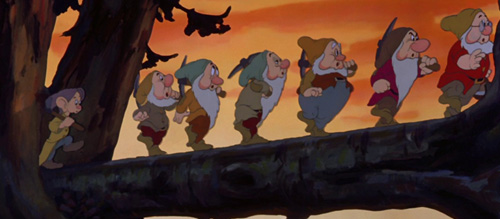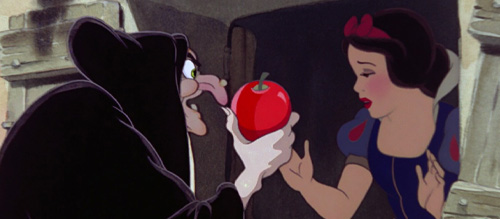‘Snow White and the Seven Dwarfs’ at 85 – Review

Snow White and the Seven Dwarfs (1937)
Director: David Hand
Screenwriters: Dorothy Ann Blank, Richard Creedon, Merrill De Maris, Otto Englander, Earl Hurd, Dick Rickard, Ted Sears, Webb Smith
Starring: Adriana Caselotti, Lucille La Verne, Harry Stockwell, Roy Atwell, Pinto Colvig, Otis Harlan, Scotty Mattraw, Billy Gilbert, Eddie Collins, Jimmy MacDonald, Moroni Olsen, Stuart Buchanan
“My sincere appreciation to the members of my staff whose loyalty and creative endeavour made possible this production.”
With this statement, Walt Disney paid tribute to his hard-working animators even before the opening credits for his first feature rolled.
Uncle Walt was nothing if not ambitious, and in 1937 (after a decade of making cartoon shorts to accompany cinema releases) he guided his studio in the bold new direction of making feature-length animated films with Snow White and the Seven Dwarfs. Its impact was seismic, it inspired generations of budding animators, it won an honorary Oscar (with, of course, seven little duplicate statues), and it kick-started an iconic production cycle of lavish fairy tale adaptations at its parent studio that has more-or-less continued to this day. 85 years on, how does the great-grandparent of animated movies play to a modern audience?
Based on the macabre fairy tale by the Brothers Grimm, we follow Snow White (Adriana Caselotti), a teenage princess whose fair beauty is envied by her narcissistic stepmother the Queen (Lucille La Verne) to such an extent that the Queen orders her death. Escaping when her assassin has a change of heart, Snow White finds her way to a cottage in the woods where she meets a band of seven dwarf miners who she cooks and cleans for while she stays with them. Before long, the Queen hatches a new dastardly plot to remove the new Fairest of Them All.
News flash: this film was made in the 1930s, in a world where gender politics were very different. Snow White is delicate and submissive and completely confirms the traditional domestic roles as a housewife. She doesn’t appear to have any ambition or dreams of her own beyond desiring a handsome prince to sweep her off her feet. It’s a product of its time and, while we can criticise outdated views, it should be seen in that context.
Some of the things achieved in 85-year-old hand-drawn animation are truly astounding; like how in the world did they do the shot of Snow White looking at her rippling reflection in the well? $1.5 million was a massive budget for any film, never mind what many might have dismissed as a really long cartoon, so Disney himself had to remortgage his home and take out a bank loan to get the project over the line. The money is all on the screen in the final product, with some of the most pristinely detailed and alive hand-drawn animation of all time. The film ended up making over $400 million at the box office.
The animation teams included Disney’s legendary “Nine Old Men” (though in the mid-1930s they were all still in their late 20s) whose talents were essential to developing the quality and style of Disney’s animation house. The rotoscoped animation (an old-timey technique where you draw over live-action reference footage) used for the more human-proportioned characters – Snow White, the Queen and the Prince – is pretty distracting, even more so in contrast with all the anthropomorphic animals and the more caricatured, stretch-squash septet of cartoon dwarfs, but it must’ve seemed like the best option available to animators at the time.
Perhaps unsurprisingly given Disney’s efforts to introduce them one by one in the film’s original theatrical trailer, all the dwarfs manage to be memorable characters in their own right, with eccentricities beyond their namesakes and a believable group chemistry. Doc’s (Roy Atwell) flustered spoonerisms, Happy’s (Otis Harlan) need to perform, Dopey’s (Eddie Collins/Jimmy MacDonald) puppyish behaviour, and Grumpy’s (Pinto Colvig) incel outbursts, all add texture to their characterisation. Astoundingly none of the voice actors were credited on the film’s release, and while it’s great that Disney’s team of animators receive such prominent billing in the opening credits, the voice talent were instrumental in giving their creations their personality.
The cheery songs by Frank Churchill and Larry Morey also go a long way to giving this story vibrancy and life, and are one of the main reasons why the film is still remembered. “Heigh-Ho” and “Whistle While You Work” in particular are rightly iconic. The fact that this was the very first commercially issued soundtrack album says a lot about how easily the songs take up residency in your head, and perhaps even more about Uncle Walt’s business acumen.

There’s a fair amount of nightmare fuel in this particular kid’s movie, from Snow White’s escape through a psychedelic dark forest to pretty much every scene with the Evil Queen. The moment where she takes a magic potion to alter her appearance to fool Snow White, transforming into an old crone in a cloud of smoke, and her sinister leering at Snow White as she tempts her with a cursed apple (so many kids must’ve used this as an excuse not to eat fruit over the decades) are among the scariest in the Disney canon. Little ones will quite understandably be watching large portions of Snow White through their fingers.
The film swaps the carefree storybook fantasy aesthetic in its final stretch for a thrilling finale straight out of a gothic horror movie – admittedly toned down from the even more twisted Grimm version – with the Dwarfs chasing the Evil Queen up a jagged mountain in a raging storm.
If there’s an aspect where the film falls short, aside from its product-of-its-time gender dynamics, it’s the relationship (or lack thereof) between Snow White and her Prince (Harry Stockwell), who doesn’t even have a name. Yes, their singing voices are both lovely, and you tend to take storytelling shortcuts in fairy tales, but she literally sings about the day “My Prince Will Come” – then he comes (not like that), goes, and then reappears at the end to proclaim himself her true love.
“Snow White” the story and this sugary sweet iteration of the character in particular have been parodied no end, both by rival studios (Dreamworks’ Shrek has her glass coffin hauled unceremoniously onto the ogre’s dining room table) and even several times by Disney itself as their films have become more self-aware (Enchanted’s cheerfully innocent Giselle is clearly chiefly inspired by Snow White). In its original animated form, Snow White is so earnest about everything, so committed to delivering a magical fairy tale experience to a young audience, that it’s easy to mock if you’re a cynical soul, but it’s even easier to love if you just want to escape the real world for 83 minutes.
Score: 20/24

